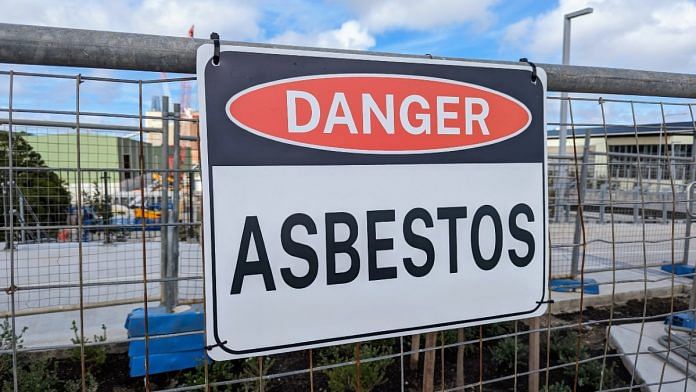Bengaluru: The US Environmental Protection Agency (EPA) Tuesday announced a ban on the only type of asbestos currently still used in the United States. The move comes decades after countries around the world as part of a concerted effort banned all types of asbestos, of which India is currently among the largest importers, due to its carcinogenic effects on the human body. Today, it is banned in construction in over 65 countries.
For instance, India enacted a ban on mining asbestos in 1993, but there is no law in the country that prevents its use in construction, import, or trade.
Besides mesothelioma or cancer of the outer layer of organs, asbestos inhalation also leads to asbestosis which produces scar tissues in lungs.
According to the International Labour Organisation (ILO), an estimated 100,000 people die each year from “work-related asbestos exposure”. At the same time, data from the World Health Organisation (WHO) suggests that about 125 million people in the world are exposed to asbestos at the workplace.
Asbestos was widely used in the construction of homes and offices throughout the USA and many other parts of the world until the later half of the 20th century, given that it is a very good electrical and heat insulator, and is strongly fire and corrosion resistant.
Also Read: It’s the brain, not the gut! What new findings reveal about semaglutide weight-loss drug
Why US ban on white asbestos now?
The American environmental agency, the US EPA, has been grappling with banning all six forms of asbestos for several decades now. Only one form of asbestos called chrysotile or white asbestos is allowed to be imported and used for tyre and brake manufacturing in the US.
The plan to implement a ban on asbestos stalled during the term of former President Donald Trump, who blamed its removal for the burning of the World Trade Center immediately after the 9/11 terrorist attacks.
All types of asbestos are carcinogenic, but chrysotile asbestos is less dangerous than the others — actinolite, amosite, anthophyllite, crocidolite, and tremolite asbestos. Amosite and crocidolite are the most hazardous, and their health hazards were established over a century ago.
Asbestos began to be commercially produced in 1879, and by 1899, lung damage from asbestos exposure was detected. The first asbestos lawsuits were filed in the 1920s, while the link between asbestos exposure and cancer was established in 1934.
Asbestos has also been used historically, and its use is well documented, including in ancient Egypt, Rome, and Greece. The accompanying medical dangers also seem to have been known, with records of lung diseases.
Fibres of asbestos can be easily and accidentally inhaled and remain embedded in the lungs once they reach there, which leads to disease.
Asbestos use in India
Despite India enacting a ban on asbestos mining enacted in 1993, there is no law in place to restrict its use in construction, import or trade. India also exports products like pipes that use asbestos.
Moreover, India is one of the largest consumers and users of asbestos globally, and accounted for 44 percent of global imports in 2021. Major imports come from Russia, Brazil, Kazakhstan, Hungary, Poland, and South Africa. Nearly all of it is chrysotile asbestos, which hasn’t been banned in Russia, but is illegal in Brazil, Hungary, Poland, and South Africa.
Indian exports of asbestos, on the other hand, were mostly sent to Bangladesh and Sri Lanka.
While India has managed to phase out asbestos from the railways, the fibrous mineral continues to be used in housing and construction, especially in roofing. Chrysotile is mixed in with cement for the purpose, but exposure to it is not minimised.
Just like in America, asbestos is also used in piping, vehicles, brake parts, and more. Though India continues to trade and use the mineral, it also provides working hazard protection and compensation for asbestos.
However, patients often find it difficult to establish a link between their exposure to asbestos and illness/cancer because in most cases symptoms and disease develop after 25-30 years.
Asbestos-related cancers and diseases are typically incurable, and lowers life expectancy to less than a decade. Diagnosis typically requires subsequent palliative care.
Health experts have continuously voiced concern about asbestos use in India and the need for awareness campaigns about it.
A 2019 research by Tata Institute of Fundamental Research (TIFR- Mumbai) on asbestos exposure in India projected that palliative care would be needed in the next four decades for six million patients with asbestos-related disease and half a million people with cancer, in India.
(Edited by Amrtansh Arora)
Also Read: Cheap alternatives, API imports — why Penicillin G production, set to resume after 30 yrs, declined



